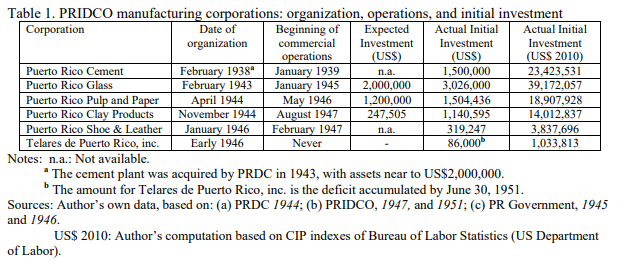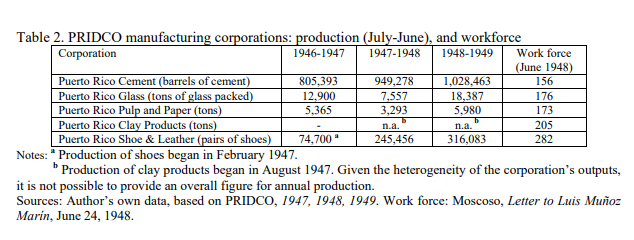NACIMIENTO DEL CAPITALISMO PUERTORRIQUEÑO DE LA POST GUERRA
Introducción
En los 1940s, cuando el Gobernador de Puerto Rico era aún designado por el Presidente de EEUU, se construyó un gran sector público empresarial. Más tarde, en 1948-1950, el primer gobierno electo de la isla privatizó esas empresas. Este trabajo documenta la creación de empresas públicas y su privatización en Puerto Rico, y analiza el papel desempeñado en la privatización por la ideología, los intereses políticos y las motivaciones económicas. Mientras que factores ideológicos pudieron ser importantes en la creación del sector público empresarial, en la privatización jugaron un papel clave factores económicos como la superior eficiencia de la empresa privada competidora en el sector de cemento, y las continuas pérdidas experimentadas en el resto de empresas manufactureras públicas.
GERMÀ BEL Universitat de Barcelona (GiM-IREA) & Barcelona Graduate School of Economics a (Forthcoming in Journal of Iberian and Latin American Economic History)
* Acknowledgements: This research received financial support from the Spanish Government (SEJ2006- 04985 & ECO2009-06946), the Government of Catalonia (SGR2009-1066), and ICREA-Academia. Most of this work was done while I was Visiting Scholar at Universidad de Puerto Rico (UPR). I have benefited from open access to the Colección Puertorriqueña in the UPR Library, and the Historical Archive of the Fundación Luis Muñoz Marín. María E. Ordóñez Mercado (CP-Library UPR) and Julio Quirós (Fundación LMM) were extremely helpful. I am particularly indebted to Silvia Álvarez Curbielo, who first directed my attention to privatization in Puerto Rico. I have benefited from comments and suggestions from Ricardo Alegría, Francisco Catalá, Fernando Fernández, Manuel Gonzalez, Mariluz Jiménez, Ana Matanzo, Efrén Rivera, and two anonymous referees. a Departament de Política i Estructura Econòmica Mundial, Universitat de Barcelona, Avd. Diagonal 690, 08034 Barcelona, Spain, e-mail: gbel@ub.edu
THE FIRST PRIVATIZATION POLICY IN LATIN AMERICA: SELLING STATEOWNED ENTERPRISES IN 1948-1950 PUERTO RICO
ABSTRACT
In the 1940s, when the Governor of Puerto Rico was still appointed by the US President, a large state-owned enterprise (SOE) sector was established. Later, in 1948-1950, the island’s first elected government privatized these SOEs. This paper documents both the creation of the SOE sector and its privatization, and analyzes the role played by ideology, political interests, and economic concerns in the decision to privatize. Whereas ideological factors might have played a significant role in the building of the SOE sector, the privatization process was driven by economic factors. In the cement sector, the competing private firm was more efficient, and the SOEs in other sectors with no private competitors in the island showed permanent losses.
Most Economics and Public Policy scholars consider the privatizations in Chile (1970searly 1980s) and the United Kingdom (1980s-early 1990s) to be the first privatization policies in modern history.1 Others argue that the first privatization operation was the denationalization of steel in the UK in 1953,2 and a few scholars see the partial sales of stateowned enterprises in Germany under Adenauer’s government (late 1950s-early 1960s) as the first large-scale privatization program.3 However, recently published works have documented and analyzed a large-scale privatization policy between 1934 and 1937 in Germany, under Hitler’s government (Bel, 2006; Bel, 2010).4. Another recent study has examined a large-scale privatization under Mussolini’s first government in Fascist Italy, between 1922 and 1925.5
Contemporary economic analyses of privatization have so far neglected an important, early case of large-scale privatization: the one carried out by the first democratically elected Governor of Puerto Rico in the late 1940s, which appears to have been the first large-scale privatization policy implemented in a democratic regime.6 A number of studies of industrial and administrative policy in Puerto Rico in the 1950s7 and 1960s8 noted the sale of stateowned enterprises between 1948 and 1950.9 However, none of these works provided an analysis on the privatization policy implemented; neither on the process, nor on the objectives. Indeed providing an analysis of the process and the objectives is the main contribution of this work.
Within two years of the first democratic gubernatorial election in Puerto Rico in 1948, the government of the Partido Popular Democrático (Democratic Popular Party) had privatized all the state-owned manufacturing firms. These firms belonged to a wide range of sectors: cement, glass, shoes, paper and chalkboard, and clay products. The enterprises that were transferred to the private sector had been created during the 1940s in an attempt to promote industrialization, and had been managed by the island’s government. The nationalization of existing public services companies (such as water, transport and energy) and the creation of state-owned enterprise sectors was an important policy in Puerto Rico in the early 1940s.
Nationalization and the expansion of the SOE sector were common in other countries in the World during the decade, but Puerto Rico was alone in reversing the trend and developing a policy of privatization of the state-owned firms in the late 1940s. In fact, in the post-war period no other country in the world engaged in such a policy until 1959, when Germany embarked on a privatization program.10 Hence, a central question remains to be answered: Why did the Puerto Rican government depart from the mainstream policies regarding State ownership in the post-World War II era, by privatizing state-owned firms?
Answering these questions requires an analysis of the objectives of the country’s privatization scheme. This paper intends to fill a gap in the economic literature by tracing the course of privatization in 1948-1950 Puerto Rico through a study of: (1) Muñoz Marín’s personal archive (accessible after the Fundación Luis Muñoz Marín was created in 1980);11 and (2) the documentation of the Puerto Rico Industrial Development Company, which only became available after they were donated to the Fundación Luis Muñoz Marín in December 2008. The analysis of privatization in Puerto Rico suggests that the objectives pursued by the island government were mostly related to economic concerns. One key factor was the poor performance of the manufacturing SOEs; another was the desire to enhance Puerto Rico’s ability to attract private capital (particularly from continental US) to invest in industries. In contrast, fiscal objectives do not seem to have been an important issue in the decision to privatize, nor did strong ideological or political motivations play a significant role.
The rest of the paper is organized as follows. First, I document the building of the Puerto Rican SOE sector. Next, I examine the privatization process and its results. After this, I analyze the objectives of the privatization policy. Finally, the main conclusions are drawn.
2. THE BUILDING OF THE STATE-OWNED ENTERPRISE SECTOR
* The Puerto Rico Glass Corporation (PR Glass, henceforth) was incorporated on February 24, 1943.28 The construction of the factory began in May 1943, and glass production began in January 1945, but production stopped due a strike between February and June 25, 1945.29 Production was resumed after the strike.
* The Puerto Rico Pulp and Paper Corporation (PR Pulp and Paper, henceforth) was organized on April 23, 1944.30 Construction began in May 1944 and the production of paperboard began on May 6, 1946.31
* The Puerto Rico Clay Products Corporation (PR Clay Products, henceforth) was created on November 6 1944;32 the preliminary work for building the clay products factory was completed by June 1945. The first kiln was completed in May 1947 and production of brick and hollow tile began in August 1947.
* The Puerto Rico Shoe and Leather Corporation (PR Shoe and Leather, henceforth) was incorporated in January 1946. The plant opened (although construction was still incomplete) on July 1, 1946, and commercial operations began in February 1947.
* Telares de Puerto Rico, inc. (PR Telares, henceforth) was incorporated in 1946, and work was scheduled to start before the end of 1946.33 But the plant was never built to be managed by PR Telares; this subsidiary was dissolved in June 1951.34
3. PRIVATIZATION OF THE STATE-OWNED MANUFACTURING FIRMS
“It is with some emotion that I tell you at the opening of this regular session of my approaching departure….I have already noted some of the credits, the largest being the program for economic rehabilitation which has been begun. And next, perhaps, the public ownership and operation of public utilities."
Please continue reading the full PDF document tables & footnotes:
http://www.ub.edu/graap/JILAH_PuertoRicoPaper_Def%20June%2019.pdf












Comentarios
Publicar un comentario